EURC: The Euro-Backed Stablecoin
The world of cryptocurrencies continues to grow with new innovations and concepts aimed at revolutionizing financial systems. Among these developments, stablecoins have emerged as a significant category. These are digital currencies designed to maintain a stable value by being pegged to real-world assets like fiat currencies or commodities. One such stablecoin making waves is EURC, a Euro-backed stablecoin.
This article provides a detailed overview of EURC, explaining its purpose, features, benefits, use cases, and its role in the digital economy.
What Is EURC?
EURC, short for Euro Coin, is a stablecoin pegged to the Euro (€). It operates on blockchain technology and maintains a 1:1 value ratio with the Euro, meaning one EURC is always equivalent to one Euro.
Unlike volatile cryptocurrencies like Bitcoin or Ethereum, EURC offers price stability, making it suitable for various financial applications. It combines the efficiency of digital assets with the reliability of a fiat currency, bridging traditional finance and decentralized finance (DeFi).
Key Features of EURC
1. Euro Pegging
EURC is pegged to the Euro, ensuring stability and reliability. Its value doesn’t fluctuate like traditional cryptocurrencies, making it a safe choice for traders and businesses.
2. Transparency
The issuance and management of EURC are often subject to regular audits. These audits ensure that every EURC in circulation is backed by an equivalent Euro held in reserves.
3. Blockchain Technology
EURC operates on blockchain networks, offering transparency, security, and efficiency in transactions.
4. Compatibility
It integrates seamlessly with decentralized finance (DeFi) platforms, enabling users to trade, lend, borrow, and stake using EURC.
5. Regulation-Friendly
EURC aims to comply with regulatory requirements, ensuring its legitimacy in various jurisdictions.
How Does EURC Work?
EURC is created (minted) and destroyed (burned) in response to supply and demand. When a user deposits Euros with the issuer, an equivalent amount of EURC is minted and provided to the user. Conversely, when a user redeems EURC for Euros, the corresponding EURC tokens are burned to maintain the 1:1 backing.
The reserves backing EURC are typically held in trusted financial institutions, ensuring the stability and trustworthiness of the token.
Benefits of EURC
1. Stability
EURC eliminates the volatility associated with cryptocurrencies, making it a reliable medium of exchange and store of value.
2. Global Transactions
Using EURC allows for faster and cheaper cross-border transactions compared to traditional banking systems.
3. Integration with DeFi
EURC can be used on DeFi platforms for trading, lending, and earning interest. Its stability makes it a preferred choice for DeFi users.
4. Accessible
Anyone with an internet connection can use EURC, making it an inclusive financial tool.
5. Hedging Against Currency Risks
For those in non-Euro countries, EURC provides a way to hedge against local currency fluctuations.
Use Cases of EURC
1. Everyday Payments
EURC can be used for buying goods and services, especially from merchants that accept cryptocurrencies.
2. Remittances
Sending money internationally using EURC is faster and cheaper than traditional remittance services.
3. Trading
Traders use EURC to hedge against cryptocurrency market volatility or as a trading pair on exchanges.
4. Lending and Borrowing
DeFi platforms enable users to lend EURC to earn interest or borrow it against collateral.
5. Savings
Holding EURC can serve as a digital savings account, especially in regions with unstable local currencies.
Challenges of EURC
1. Regulatory Uncertainty
Cryptocurrency regulations vary across countries. EURC must navigate the complexities of regulatory frameworks in the Eurozone.
2. Adoption
While USD-backed stablecoins dominate the market, EURC needs to establish itself among users and businesses.
3. Trust in Reserves
Users must trust that EURC is fully backed by Euros held in reserves. Regular audits and transparency are essential to maintain trust.
The Role of EURC in DeFi
DeFi platforms thrive on stablecoins, and EURC is no exception. It enables Euro-based transactions, adding diversity to the predominantly USD-dominated DeFi ecosystem.
Examples of EURC in DeFi:
• Liquidity Pools: Providing EURC liquidity to earn rewards.
• Yield Farming: Staking EURC to earn interest or rewards.
• Collateral: Using EURC as collateral for loans.
How to Use EURC
1. Get a Wallet
Choose a cryptocurrency wallet that supports EURC. Examples include hardware wallets, mobile wallets, and browser-based wallets.
2. Buy EURC
You can buy EURC from cryptocurrency exchanges or directly from the issuer by depositing Euros.
3. Transact
Use EURC for payments, transfers, or investments.
4. Integrate with DeFi
Explore DeFi platforms to trade, lend, or borrow using EURC.
The Future of EURC
As the cryptocurrency landscape evolves, EURC is expected to gain more traction. Its focus on stability, transparency, and Eurozone integration positions it as a strong contender in the stablecoin market.
Potential developments include:
• Increased adoption by businesses and individuals in the Eurozone.
• Integration with more DeFi platforms and blockchain networks.
• Enhanced regulatory compliance to build trust and legitimacy.
Conclusion
EURC, the Euro-backed stablecoin, represents a significant step towards integrating traditional finance with blockchain technology. Its stability, transparency, and compatibility with DeFi make it a valuable tool for users and businesses alike.
Whether you’re a trader, business owner, or casual user, EURC offers a secure and efficient way to participate in the digital economy while staying rooted in the Eurozone. As adoption grows, EURC is poised to play a pivotal role in the future of digital finance.





Comments
Post a Comment